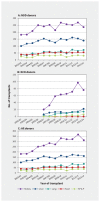Effect of organ donation after circulatory determination of death on number of organ transplants from donors with neurologic determination of death
- PMID: 28947546
- PMCID: PMC5621932
- DOI: 10.1503/cmaj.161043
Effect of organ donation after circulatory determination of death on number of organ transplants from donors with neurologic determination of death
Abstract
Background: To increase the available pool of organ donors, Ontario introduced donation after circulatory determination of death (DCD) in 2006. Other jurisdictions have reported a decrease in donations involving neurologic determination of death (NDD) after implementation of DCD, with a drop in organ yield and quality. In this study, we examined the effect of DCD on overall transplant activity in Ontario.
Methods: We examined deceased donor and organ transplant activity during 3 distinct 4-year eras: pre-DCD (2002/03 to 2005/06), early DCD (2006/07 to 2009/10) and recent DCD (2010/11 to 2013/14). We compared these donor groups by categorical characteristics.
Results: Donation increased by 57%, from 578 donors in the pre-DCD era to 905 donors in the recent DCD era, with a 21% proportion (190/905) of DCD donors in the recent DCD era. However, overall NDD donation also increased. The mean length of hospital stay before declaration for NDD was 2.7 days versus 6.0 days before withdrawal of life support and subsequent asystole in cases of DCD. The average organ yield was 3.73 with NDD donation versus 2.58 with DCD (p < 0.001). Apart from hearts, all organs from DCD donors were successfully transplanted. From the pre-DCD era to the recent DCD era, transplant activity in each era increased for all solid-organ recipients, including heart (from 158 to 216), kidney (from 821 to 1321), liver (from 477 to 657) and lung (from 160 to 305).
Interpretation: Implementation of DCD in Ontario led to increased transplant activity for all solid-organ recipients. There was no evidence that the use of DCD was pre-empting potential NDD donation. In contrast to groups receiving other organs, heart transplant candidates have not yet benefited from DCD.
© 2017 Canadian Medical Association or its licensors.
Conflict of interest statement
Competing interests: Vivek Rao is a member of the board of directors for the Trillium Gift of Life Network, has served on advisory boards for Medtronic and CorMatrix Cardiovascular and is a member of the speakers’ bureau for St. Jude Medical. Sonny Dhanani was formerly the chief medical officer for the Trillium Gift of Life Network (2010–2016). No other competing interests were declared.
Figures



Comment in
-
Trends in deceased organ donation in Canada.CMAJ. 2017 Sep 25;189(38):E1204-E1205. doi: 10.1503/cmaj.170988. CMAJ. 2017. PMID: 28947545 Free PMC article. No abstract available.
References
-
- Bernhardt AM, Reichenspurner H. High-risk donors: extending our criteria in times of organ shortage. Curr Opin Organ Transplant 2014;19:494–9. - PubMed
-
- Prieto D, Correia P, Baptista M, et al. Outcome after heart transplantation from older donor age: expanding the donor pool. Eur J Cardiothorac Surg 2015;47:672–8. - PubMed
-
- Lim GB. Transplantation: ex-vivo perfusion of human hearts — implications for donor organ availability. Nat Rev Cardiol 2015;12:317. - PubMed
-
- Weber M, Dindo D, Demartines N, et al. Kidney transplantation from donors without a heartbeat. N Engl J Med 2002;347:248–55. - PubMed
MeSH terms
LinkOut - more resources
Full Text Sources
Other Literature Sources
Medical
